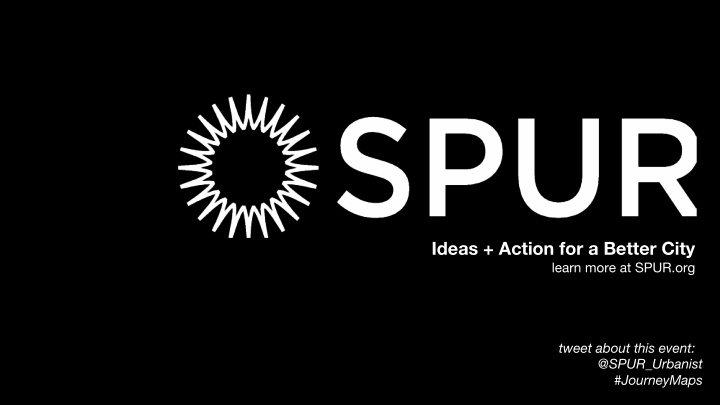



Ideas + Action for a Better City learn more at SPUR.org tweet about this event: @SPUR_Urbanist # JourneyMaps
Understanding Rider Experiences with Journey Maps Amanda Damewood amanda@hcdcoach.com
Amanda Damewood Many years in nonprofit administration ● BA in Art History, MA in Museum Studies ● General Assembly UX Intensive Grad ● 2016-17 Code for America Fellow ● Self-employed service design coach ● and adjunct faculty at SFSU
Agenda What is human-centered design? ● When, how, and why of journey maps ● A little about good questions ● Practice: Let’s make journey maps! ● How do we use journey maps? ● Takeaways ●
User-Centered Design Make Something Build Understand Learn Measure Observe Illustration: Laura Urquiaga
Ecosystem Illustration: Laura Urquiaga
Image by Microsoft
When + How ● “Enough” research is when you’ve spoken to 5 users* about their experience As a research artifact, journey maps document the steps a customer took in a process ● It’s a step-by-step document of an entire process ● It’s best when you can share it ●
Why? Because journey maps are the first step to understanding how customers perceive your service or process: You can use them to align conversations around something visual ● Because they document an entire process, they can help cross-functional communication ● Multiple journey maps can help you see efficiencies and potential improvements ●
I get to my hotel in time for I was so excited to get my travel Once I landed, I found the Clipper dinner with colleagues, but only approved for the big conference desk at SFO. just. in San Francisco! 3 weeks ago Yesterday morning Finally... 2 weeks ago Later yesterday... I’m from Europe, so I couldn’t The desk only takes cash so I download the Muni app from have to go to the train station my version of the App Store. and buy a paper ticket. Journey Map Example
Good questions (taken from a 5 part course) Talk about something the participant has done, rather than what they think they would do ● Start with a specific prompt ● “Tell me about a time when…” ○ “How did you feel when you…” ○ Don’t include language you’re hoping to hear in your questions ● Keep your voice and body language warm but neutral so that subjects won’t tell you what they ● think you want to hear Use open-ended questions to give people space to tell you what they think is important ●
Let’s do it! Take 3 minutes to interview the person next to you about the last time they bought someone a gift: Who was the gift for? ○ What was the occasion? ○ What did they do first? Next? Etc. ○ Take some notes! At the end of 3 minutes, we’ll switch.
What did you hear?
Draw a journey map for your partner’s gift-giving experience
It’s a series of steps... Write them down in order, horizontally: What happened first? ○ Then what happened? ○ How did the gift giver know they were “done”? ○
Care to share?
You made a map...now what?! Start conversations across departments about what you’ve learned ● Identify opportunities for deeper feedback or measurement ● Create a journey map within your office to identify pain points and ● prototype something to fix them Use the findings to make small changes in your workplace or program. ● Simplify internal processes and procedures ●
Compare Maps Show the map you made to someone new. What’s similar? What’s different? What surprises you?
Journey Map - Highs + Lows Graphic: www.joycehostyn.com
Identify Highs and Lows Put a + or ↑ on positive parts of the experience, and - or ↓ on negative parts. Think: Why was it positive or negative? ○ How can we index up on the positives? ○ What could make the negatives less impactful? What would it take ○ to eliminate them?
Prototype Draw something that would make the experience better: Digital ○ Handheld ○ Environmental ○ Person-to-person ○
Test Show what you drew to the person you interviewed. Share with them the positive or negative part of the experience you identified, and ask for their input on your prototype. Potential questions: “Do you think this would solve your problem?” ○ “Do you think this would improve your experience?” ○ “Does this look like it’s for someone like you? Why or why not?” ○
Reflection + Questions What did I learn today? ● What do I want to share with my colleagues? ● Write one thing you can use journey mapping for in your office (or ● home?)
Thank you! Email me with questions or feedback: amanda@hcdcoach.com Mention this workshop and get 10% off an onsite workshop for 8
Rational-Analytical Thinking Problem Formulation Well-defined goals/constraints Criteria Objective definition of criteria, established before generation of alternatives Method Planning + analysis; sequential process Information Processing Objective formulations, especially verbal + quantitative Solution Process Based on rational-logical reasoning process; formalized into set of rules Rationale Reduce chance of failure through careful prior analysis Solution optimizes predefined criteria to arrive at “best” answer Outcome
Design Thinking Problem Formulation Goals/constraints uncovered during process Criteria Both objective + subjective criteria used to define design objectives Method Iterative exploration of design space; thinking + doing are intertwined Information Processing Visual + spatial representations; objective + subjective insights Solution Process Solutions evolve as result of interaction with users; incorporates insights Rationale Use rapid experimentation + prototyping to learn from early “failures” Outcome Obtain “better” answer; process may expose additional problems + solutions
Ideas + Action for a Better City learn more at SPUR.org tweet about this event: @SPUR_Urbanist # JourneyMaps
Recommend
More recommend